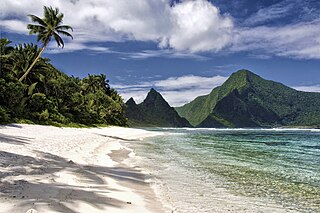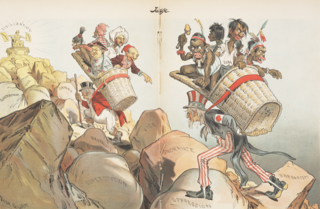Related Research Articles

The Philippine–American War, known alternatively as the Philippine Insurrection, Filipino–American War, or Tagalog Insurgency, was fought between the First Philippine Republic and the United States from February 4, 1899, until July 2, 1902. Tensions arose after the United States annexed the Philippines under the Treaty of Paris at the conclusion of the Spanish–American War rather than acknowledging the Philippines' declaration of independence. The war can be seen as a continuation of the Philippine struggle for independence that began in 1896 with the Philippine Revolution against Spanish rule.

The Treaty of Peace between the United States of America and the Kingdom of Spain, commonly known as the Treaty of Paris of 1898, was signed by Spain and the United States on December 10, 1898, that ended the Spanish–American War. Under it, Spain relinquished all claim of sovereignty over and title to territories described there as the island of Porto Rico and other islands now under Spanish sovereignty in the West Indies, and the island of Guam in the Marianas or Ladrones, the archipelago known as the Philippine Islands, and comprehending the islands lying within the following line:, to the United States. The cession of the Philippines involved a compensation of $20 million from the United States to Spain.

In the law of the United States, an insular area is a U.S.-associated jurisdiction that is not part of a U.S. state or the District of Columbia. This includes fourteen U.S. territories administered under U.S. sovereignty, as well as three sovereign states each with a Compact of Free Association with the United States. The term also may be used to refer to the previous status of the Swan Islands, Hawaii, Puerto Rico, and the Philippines, as well as the Trust Territory of the Pacific Islands when it existed.

Territories of the United States are sub-national administrative divisions overseen by the federal government of the United States. The various American territories differ from the U.S. states and Indian reservations as they are not sovereign entities. In contrast, each state has a sovereignty separate from that of the federal government and each federally recognized Native American tribe possesses limited tribal sovereignty as a "dependent sovereign nation." Territories are classified by incorporation and whether they have an "organized" government through an organic act passed by the Congress. American territories are under American sovereignty and, consequently, may be treated as part of the United States proper in some ways and not others. Unincorporated territories in particular are not considered to be integral parts of the United States, and the Constitution of the United States applies only partially in those territories.

The Asiatic Squadron was a squadron of United States Navy warships stationed in East Asia during the latter half of the 19th century. It was created in 1868 when the East India Squadron was disbanded. Vessels of the squadron were primarily involved in matters relating to American commerce with China and Japan, though it participated in several conflicts over 34 years of service until becoming the Asiatic Fleet in 1902.

Edward David Taussig was a decorated Rear Admiral in the United States Navy. He is best remembered for being the officer to claim Wake Island after the Spanish–American War, as well as accepting the physical relinquishment of Guam by its Spanish governor following the Treaty of Paris in which Spain ceded Guam to the United States following nearly 300 years of colonial rule. Taussig briefly served as Governor of Guam. He was the first of a four-generational family of United States Naval Academy graduates including his son, Vice Admiral Joseph K. Taussig (1877–1947), grandson Captain Joseph K. Taussig Jr. (1920–1999), and great-grandson, Captain Joseph K. Taussig USMC (1945–).

"The White Man's Burden" (1899), by Rudyard Kipling, is a poem about the Philippine–American War (1899–1902) that exhorts the United States to assume colonial control of the Filipino people and their country. Originally written to celebrate the Diamond Jubilee of Queen Victoria, the jingoistic poem was replaced with the sombre "Recessional" (1897), also a Kipling poem about empire.

Maug consists of a group of three small uninhabited islands. This island group is part of the Northern Islands Municipality of the Commonwealth of the Northern Mariana Islands, itself part of the Marianas archipelago in the Oceanian sub-region of Micronesia.

The history of the Philippines from 1898 to 1946 is known as the American colonial period, and began with the outbreak of the Spanish–American War in April 1898, when the Philippines was still a colony of the Spanish East Indies, and concluded when the United States formally recognized the independence of the Republic of the Philippines on July 4, 1946.
The United States House Committee on Insular Affairs is a defunct committee of the U.S. House of Representatives.

The Treaty of Manila of 1946, formally the Treaty of General Relations and Protocol, is a treaty of general relations signed on July 4, 1946, in Manila, the capital of the Philippines. It relinquished U.S. sovereignty over the Philippines and recognized the independence of the Republic of the Philippines. The treaty was signed by High Commissioner Paul V. McNutt as representative of the United States and President Manuel Roxas as representative of the Philippines.

The German–Spanish Treaty of 1899, signed by the German Empire and the Kingdom of Spain, involved Spain selling the majority of its Pacific possessions not lost in the Spanish–American War to Germany for 25 million pesetas.

USS Supply, ex-Illinois, was a schooner-rigged iron steamer built in 1873 by William Cramp & Sons of Philadelphia. Illinois was purchased by the Navy Department from the International Navigation Company on 30 April 1898 for $325,000.00 and commissioned as Supply, Lt. Comdr. R. R. Ingersoll in command.
José Sisto, also called José Sisto Rodrigo and José Sixto, was twice Governor of Guam, first after overthrowing Francisco Martínez Portusach, and again after being legitimately placed in the position by the United States government. He served as Spanish administrator of the Public Treasury in Guam until the United States captured the island during the Spanish–American War. When Martínez was named Commissioner, Sisto quickly staged a coup d'état and claimed the position as the highest ranking Spanish official on the island. He began arming native guards and commandeering ammunition, but was briefly overthrown by Venancio Roberto and other pro-American elements on December 31, 1898, but was officially put into power by officers of the United States Navy only two days later after they decided he held a legitimate claim to the position. His second term was brief, and he officially relinquished control on February 1, 1899 after learning that the United States had obtained Guam.
William Elbridge Sewell was a United States Navy Lieutenant Commander and the 6th Naval Governor of Guam from February 9, 1903, until he returned to the mainland United States for medical treatment on January 11, 1904. He was born in Colchester, New York, and appointed to the United States Naval Academy from that state in 1867. He served on numerous ships before becoming an ensign, and eventually became executive officer or commanding officer of a series of ships and installations. He then became commanding officer of the Guam flagship, and soon after, governor of Guam. As governor, he initiated a series of tax and legal reforms, including many that restored the rights of the native population to practice their culture more freely. He legalized and taxed alcohol and set up a court system that lasted 30 years. In January 1904, he fell ill from intestinal troubles and was transported to California for treatment, where he died while still in office.
George Robert Salisbury was a United States Navy Commodore who served as the 15th Naval Governor of Guam. Though he originally served as an Engineering Duty Officer, he eventually stopped being a Restricted Line Officer, and retired from the Navy as a Commodore. As governor, he rolled back a number of educational reforms and encouraged a new ranch system. He also took drastic measures to control the leprosy epidemic on the island, removing the infected to Philippines. He was briefly called into service during World War I before retiring.

The United States Military Government of the Philippine Islands was a military government in the Philippines established by the United States on August 14, 1898, a day after the capture of Manila, with General Wesley Merritt acting as military governor. During military rule (1898–1902), the U.S. military commander governed the Philippines under the authority of the U.S. president as Commander-in-Chief of the United States Armed Forces. After the appointment of a civil Governor-General, the procedure developed that as parts of the country were pacified and placed firmly under American control, responsibility for the area would be passed to the civilian.
Guam is an island in the Marianas archipelago of the Northern Pacific located between Japan and New Guinea on a north–south axis and Hawaii and the Philippines on an east–west axis. Inhabitants were Spanish nationals from 1521 until the Spanish–American War of 1898, from which point they derived their nationality from United States law. Nationality is the legal means in which inhabitants acquire formal membership in a nation without regard to its governance type. In addition to being United States nationals, people born in Guam are both citizens of the United States and citizens of Guam. Citizenship is the relationship between the government and the governed, the rights and obligations that each owes the other, once one has become a member of a nation. Though the Constitution of the United States recognizes both national and state citizenship as a means of accessing rights, Guam's history as a territory has created both confusion over the status of its nationals and citizenship and controversy because of distinctions between jurisdictions of the United States.
References
- ↑ Charles Henry Butler (1902). The treaty making power of the United States. The Banks Law Pub. Co. p. 441 . Retrieved April 9, 2011.